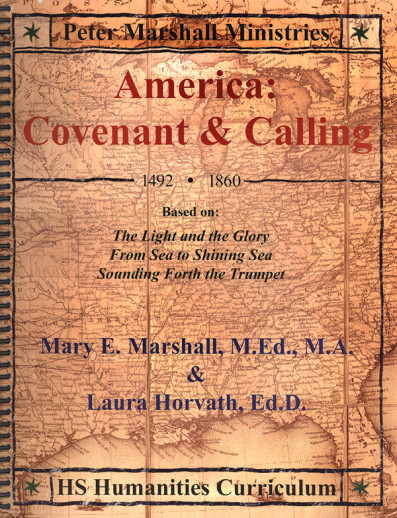We use cookies to make your experience better. To comply with the new e-Privacy directive, we need to ask for your consent to set the cookies. Learn more.
America: Covenant & Calling High School Humanitites Curriculum
Providing a solid foundational understanding of the providence of God in our nation's history, this one semester high school humanities course is an essential resource to solidify the Christian ideals of our young people as they prepare to enter the market place of ideas. Using Peter Marshall's popular books: The Light and the Glory, From Sea to Shining Sea, and Sounding Forth the Trumpet, as spine resources, this study covers American history from 1492-1860 with a specific focus on four major themes: Call, Covenant, Repentance, and the Leader as a Servant. Throughout this one semester study, students are also required to conduct a community based project putting these principles into practice.
Beginning with an 18-week lesson guideline, this curriculum is organized in a clear, easy to use format. The three core books have been organized into sections (called parts), and each part has further been developed to offer introductions, learning objectives, continuing themes, key words and concepts, key people and places, video and audio recommendations, supplemental reading recommendations, activity suggestions, writing/Socratic seminar topics and research ideas. Time spent on each part varies from one day to one week.
Let me share an example from Part 19 (expected to take 3 days). Students begin by reading chapters 10-11 in the book, "From Sea to Shining Sea". The introduction covers how inherently wrong slavery is from our modern perspective, as well as the perspective of the majority of Christians in the early 19th century. The objectives focus on understanding the history of slavery in America, understanding why slavery did not develop in the North as the South, the impact of slavery on every political debate in America, the incompatibility of slavery in light of our Declaration of Independence, the realistic picture of slavery and the picture of Christianity role in the lives of slaves and slave holders. Continuing themes focus on God's selection of individuals and His perfect timing as well as how power can blind even good-hearted individuals and the love of money. Key Words and Concepts along with Key People and Places are provided. A sampling of the recommendations for viewing, listening and reading include: Roots, The Great Civil War Debate (Rev. Peter Marshall vs. Rev. Steve Wilkins) among others in the viewing category; a link to listen to Negro spirituals; and several links to online resources to read. Writing/Socratic Seminar Topic suggestions are numerous. For example: "Explain the impact of the cotton gin; or Chapter 11 teaches us that the public was very aware of the realities of slavery, yet seemingly remained indifferent to it. Are there parallels today? How can you explain why we ignore them?" Additionally, five research ideas are presented. As you can see based on the scope of options available, families can chose to expand these areas, creating a more in-depth study or select from the options to create a well-rounded study.
At the heart of this study is the Reflective Notebook (RN) students are required to create. Following the principle approach to education, this notebook is designed to train independent thinkers and writers and will contain class assignments and notes along with journal entries, reflection entries, and a place to process their learning and express opinions and feelings. While many of the activities are easy to incorporate at home, you may find some of the projects lend themselves to a group or co-op setting, making this a versatile study for many homeschool families.
An expansive appendix offers beneficial resources including: a summary of dominant American values; suggestions for the reflective notebook; ideas/guidelines for the various projects including the covenant (social justice) project, American values multi-media project, American body biography project, viewing and reading guides; how to "read" art; final assessment ideas; supplemental reading lists organized by topic and time period; and additional teaching resources. Required for this study are the three spine books written by Peter Marshall, a spiral bound notebook (I would use a three ring binder for more versatility), highlighters, colored pencils/magic markers for map work, and butcher paper. Spiral. 240 pgs. ~ Deanne
| Product Format: | Softcover Book |
|---|---|
| Brand: | Peter Marshall Ministries |
| Author: | Mary Marshall & Laura Horvath |
| Grades: | 9-12 |
| Length in Inches: | 11 |
| Width in Inches: | 9 |
| Height in Inches: | 0.75 |
| Weight in Pounds: | 1.75 |

